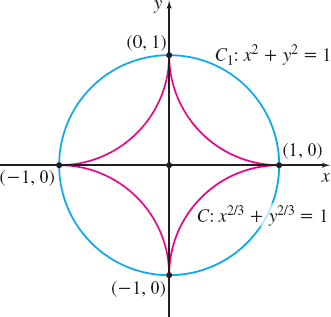EXAMPLE 4Using Green’s Theorem to Find a Line Integral
Find ∮C(−yx2+y2dx+xx2+y2dy) if:
- (a) C is the curve x2/3+y2/3=1, whose orientation is counterclockwise.
- (b) C is any piecewise-smooth, simple closed curve not containing the origin in its interior.
1013
Solution For P=−yx2+y2 and Q=xx2+y2, we have ∂P∂y=y2−x2(x2+y2)2and∂Q∂x=y2−x2(x2+y2)2
Notice that, except at the point (0,0), the partial derivatives ∂P∂y and ∂Q∂x are continuous.
(a) It is difficult to find the line integral along C. Moreover, because x2/3+y2/3=1 contains the point (0,0) in its interior, we cannot use Green’s Theorem as we did in Example 2 to change the line integral to a double integral. However, since ∂P∂y=∂Q∂x throughout R, we can use a different curve that leads to an easier line integral. For example, suppose we replace x2/3+y2/3=1 by the unit circle C1: x2+y2=1, noting that the conditions required for ∫C(Pdx+Qdy) to equal ∫C1(Pdx+Qdy) are met. See Figure 38.
On C1, x=cosθ, y=sinθ, 0≤θ≤2π. Then dx=−sinθdθ, dy=cosθdθ, and ∮C(−yx2+y2dx+xx2+y2dy)=∮C1(−yx2+y2dx+xx2+y2dy)=∫2π0(sin2θ+cos2θ)dθ=2π
(b) In this case, the interior of the curve C does not contain the origin. Since ∂P∂y=∂Q∂x
in the simply connected region R enclosed by C, it follows that F=P(x,y)i+Q(x,y)j is a conservative vector field. Since C is closed, ∮C(−yx2+y2dx+xx2+y2dy)=∮CF⋅dr=0
